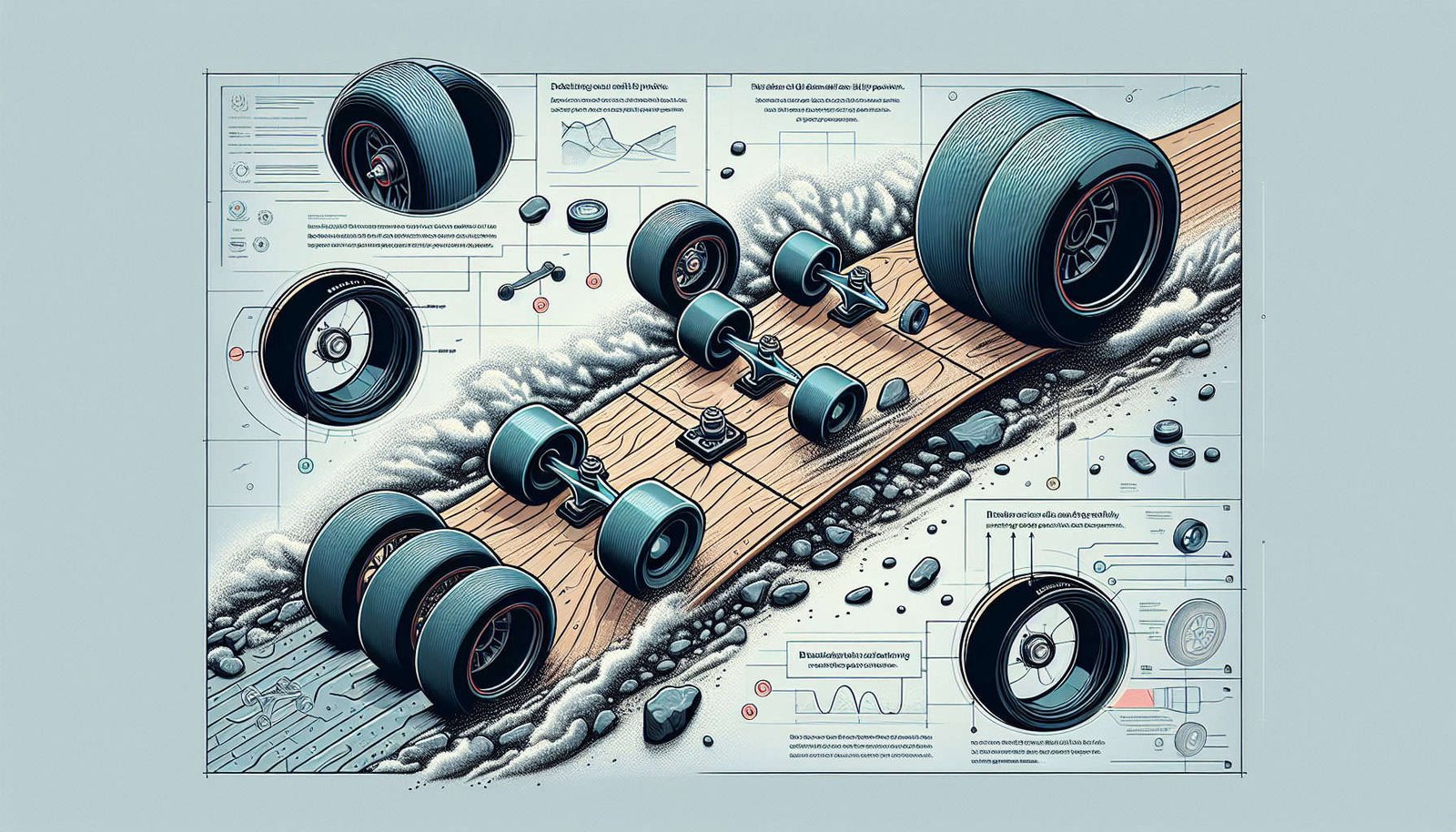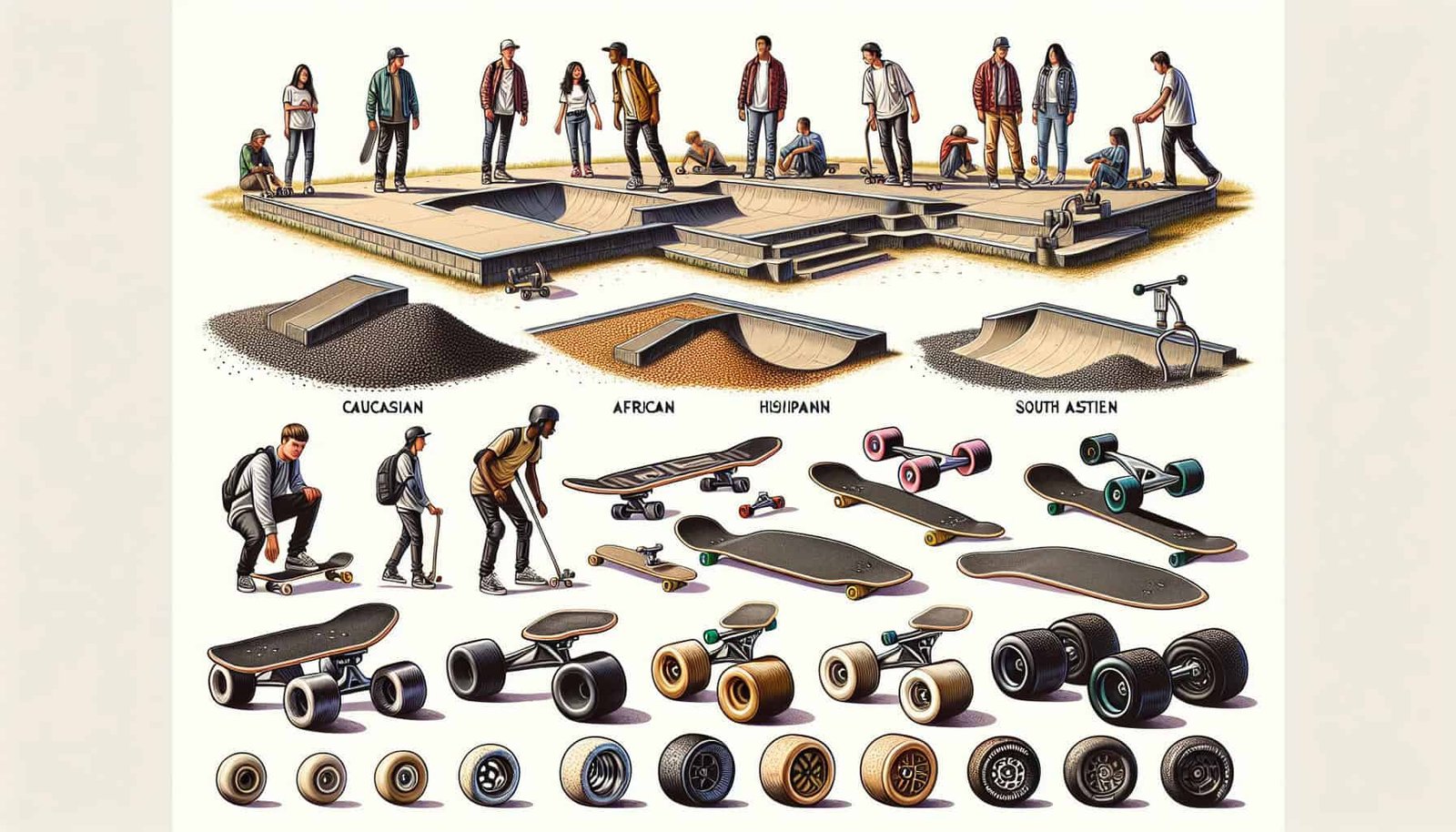We all love the exhilarating feeling of cruising down the streets on our skateboards, but what happens when you come across different surfaces that make your ride a little less smooth? Fear not, because in this article, you’ll discover the secrets of adjusting your skateboard wheel size to conquer any type of terrain. From the crackled pavement to the rugged off-road paths, find out how to optimize your ride for maximum control and an unforgettable skateboarding experience like no other. So grab your board and let’s dive into the world of skateboard wheel adjustments!
Choosing the Right Skateboard Wheel Size
Skateboarding is not just a sport; it’s a way of life. Whether you’re carving up the streets or tearing it up at the skate park, having the right skateboard wheel size can make all the difference. But with so many options available, how do you know which wheel size is right for you? Don’t worry – we’ve got you covered. In this article, we will explore the various factors to consider when choosing a skateboard wheel size, as well as the benefits and challenges associated with different wheel sizes on different surfaces. So, grab your board, sit back, and let’s dive in!
Factors to Consider
When it comes to deciding on the perfect skateboard wheel size, there are a few important factors to consider. The first and most critical factor is the type of surface you’ll be riding on. Different wheel sizes perform better on different terrains, so understanding the characteristics of your riding environment is crucial. Secondly, your personal skateboarding style also plays a significant role in determining the ideal wheel size for you. Finally, it’s important to consider your skill level. Beginners may find it easier to ride with larger wheels, while more experienced skaters might prefer smaller, more maneuverable wheels. By taking these factors into account, you’ll be well on your way to finding the perfect skateboard wheel size for your needs.
Understanding Wheel Size Measurements
Before we delve into the specific wheel sizes for different surfaces, it’s crucial to understand how wheel size is measured. Skateboard wheels are typically measured in millimeters (mm) and consist of two key measurements – diameter and width. The diameter refers to the size of the wheel from one side to the other, while the width indicates how wide the wheel is. For example, a wheel with a diameter of 52mm and a width of 32mm would be labeled as 52x32mm. Remember, the size of your skateboard wheels can greatly impact your riding experience, so choose wisely!

Different Wheel Sizes for Different Surfaces
Now that we have a good grasp of the factors to consider and understand how wheel size is measured, let’s explore the various wheel sizes for different surfaces. It’s essential to match your wheel size to the terrain you’ll be riding on to maximize performance, stability, and control.
Adjusting Wheel Size for Smooth Surfaces
If you’re lucky enough to have access to smooth pavement or concrete surfaces, such as roads or skate parks, you can optimize your riding experience by using smaller wheels. Smaller wheel sizes, typically ranging from 50-54mm, are ideal for smooth surfaces as they provide a more responsive ride and enhanced maneuverability. These wheels are perfect for executing technical tricks, such as flip tricks and grinds. Additionally, smaller wheels tend to be lighter, making them easier to control and accelerate. So, if you primarily ride on smooth surfaces, consider opting for smaller wheels to elevate your skating skills to new heights!
Benefits of Using Small Wheels on Smooth Surfaces
Using small wheels on smooth surfaces offers several advantages. Firstly, smaller wheels provide increased grip, ensuring better traction on the pavement. This enhanced grip allows for tighter turns and quicker changes in direction, making it easier to navigate crowded skate parks or busy streets. Secondly, small wheels are more responsive, allowing for quicker acceleration and deceleration. This responsiveness is crucial for executing precise tricks, jumps, and fast maneuvers. Lastly, smaller wheels are generally more stable due to their lower center of gravity. This stability helps prevent wobbles and provides a solid foundation for landing tricks. So, don’t underestimate the benefits of using small wheels – they can truly take your skating to the next level on smooth surfaces.

Adjusting Wheel Size for Rough Surfaces
On the other hand, if you find yourself frequently riding on rough terrain, such as sidewalks or uneven asphalt, larger wheels are the way to go. Larger wheel sizes, typically ranging from 55-60mm or even larger, are better suited for rough surfaces as they offer a smoother, more comfortable ride. These wheels provide better shock absorption, allowing you to roll over cracks and pebbles without losing stability or momentum. Additionally, larger wheels offer more speed, making them perfect for cruising around town or tackling long, downhill stretches. So, if you often find yourself skating on rough surfaces, it’s time to invest in some larger wheels!
Benefits of Using Large Wheels on Rough Surfaces
Using large wheels on rough surfaces yields a multitude of benefits. The most significant advantage is better shock absorption, which helps dampen vibrations and impacts from uneven terrain. This enhanced shock absorption results in a smoother ride and reduces the risk of getting ejected from your board. Large wheels also excel in maintaining momentum over bumps or cracks, allowing you to maintain your speed and flow while cruising through urban landscapes. Furthermore, the greater height of larger wheels increases the distance between the axle and the ground, minimizing the chances of wheel bite. Wheel bite occurs when the wheels catch on the deck, causing the rider to lose control. By using large wheels on rough surfaces, you’ll be able to skate with confidence and conquer any obstacle that comes your way.
Tips for Riding Large Wheels on Rough Surfaces
While riding on larger wheels can be beneficial on rough surfaces, it’s important to keep a few tips in mind to ensure a safe and enjoyable experience. Firstly, be prepared for a different riding feel compared to smaller wheels. The increased height and weight of larger wheels require adjustments to your balance and foot placement. Take some time to get comfortable with the new riding sensation before attempting any challenging maneuvers. Secondly, maintain a relaxed and stable stance to absorb the impact of rough terrain. Bend your knees slightly and distribute your weight evenly over the board to maintain control and stability. Lastly, always be aware of your surroundings and anticipate potential obstacles. Rough surfaces may conceal potholes, cracks, or rocks, so remain vigilant to avoid any accidents. With these tips in mind, you’ll be ready to conquer any rough surface with style and confidence!

Adjusting Wheel Size for Skate Parks
Skate parks are a skater’s playground, where creativity and skill combine to create stunning displays of talent. Choosing the ideal wheel size for skate parks is crucial to optimize your performance and enjoyment. Let’s explore the options!
Choosing the Ideal Wheel Size for Skate Parks
When it comes to skate parks, the ideal wheel size lies in the middle ground between small and large wheels. Wheel sizes ranging from 53-58mm are generally preferred in skate parks. This size strikes a balance between maneuverability and stability, allowing skaters to execute technical tricks while maintaining control on transitions and ramps. The slightly larger size offers better shock absorption, which is beneficial for landing tricks and absorbing impact during high-flying aerial maneuvers. So, whether you’re grinding rails, launching off ramps, or perfecting your transition game, a medium-sized wheel is the way to go!
Benefits and Challenges of Different Wheel Sizes in Skate Parks
Using medium-sized wheels in skate parks offers a range of benefits. Firstly, the increased size provides a solid foundation for landing tricks, ensuring a smoother, more controlled landing. Secondly, the slightly larger size helps maintain speed and flow during transitions, allowing for smoother lines and uninterrupted runs. Lastly, medium-sized wheels offer excellent stability, making it easier to maintain balance and control while riding obstacles or executing technical maneuvers. However, it’s worth noting that medium-sized wheels may be slightly less maneuverable compared to smaller wheels. This reduced maneuverability can make executing certain flip tricks or technical slides slightly more challenging. Nevertheless, with practice and proper technique, the benefits of medium-sized wheels far outweigh the challenges in a skate park setting.

Adjusting Wheel Size for Street Skating
Street skating is all about exploring urban environments, utilizing every feature, and letting your creativity shine. To navigate the diverse range of surfaces found on the streets, having the optimal wheel size is essential. Let’s explore the options for street skating!
Optimal Wheel Size for Street Skating
For street skating, the ideal wheel size falls within the range of 50-55mm. These sizes provide the perfect balance between maneuverability, stability, and versatility. Street skating demands quick and agile movements, and smaller wheels excel at delivering the necessary responsiveness. These wheels allow for precise flips, slides, and grinds while navigating curbs, ledges, and rails. The smaller size also provides optimal control for technical tricks and street-style skating, where precision and accuracy are paramount. So, if you’re hitting the streets, be sure to equip your board with smaller wheels to unlock your full creative potential!
Advantages of Using Specific Wheel Sizes for Street Skating
Using specific wheel sizes for street skating brings numerous advantages to the table. Firstly, smaller wheels provide faster acceleration, allowing you to explode into tricks and navigate obstacles with ease. The increased responsiveness and quicker speed help execute flip tricks with precision and style. Secondly, the compact size of smaller wheels enhances maneuverability, making it easier to weave through traffic, dodge pedestrians, and conquer tight spots. Additionally, smaller wheels offer better control and stability on varied street surfaces, allowing for smoother slides and grinds on curbs and rails. By harnessing the advantages of specific wheel sizes for street skating, you’ll be able to push your limits and showcase your skills in any urban environment!

Effects of Wheel Hardness on Different Surfaces
So far, we’ve explored the importance of wheel size in various skateboarding scenarios. However, it’s essential to consider another critical factor that influences performance – wheel hardness, also known as durometer. Let’s dive into the significance of wheel durometer and its effect on different surfaces.
Significance of Wheel Durometer
Wheel durometer refers to the hardness of the wheel’s urethane compound. Durometer is measured using the ‘A’ scale, with higher numbers indicating harder wheels and lower numbers representing softer wheels. The durometer rating greatly affects the performance of your skateboard wheels on different terrains. Softer wheels, generally ranging from 78A to 87A, offer excellent grip and shock absorption, making them perfect for cruising on rough surfaces or tackling transitions in skate parks. Conversely, harder wheels, ranging from 88A to 101A or beyond, provide less grip but are faster and more responsive. Harder wheels are ideal for smooth surfaces, such as skate parks or indoor ramps. By understanding the significance of wheel durometer, you can further optimize your skateboarding experience.
Ideal Wheel Hardness for Specific Surfaces
Now that we understand the impact of wheel durometer, let’s explore the ideal wheel hardness for specific surfaces. If you primarily ride on rough surfaces, such as streets or sidewalks, softer wheels with a durometer rating of 78A to 87A are recommended. These softer wheels offer excellent grip, ensuring traction and control on uneven terrain. The increased shock absorption helps cushion the impact of cracks or bumps, resulting in a smoother ride. On the other hand, if you skate predominantly in skate parks or on smooth surfaces, harder wheels in the range of 88A to 101A or beyond are more suitable. These harder wheels provide faster speed, increased responsiveness, and better slide capabilities on smooth, polished surfaces. By selecting the right wheel hardness for specific surfaces, you can maximize your performance and enjoy a more tailored skateboarding experience.
Considering Personal Preferences
While the factors we’ve discussed so far are essential in determining the ideal skateboard wheel size, it’s essential not to overlook personal preferences. Skateboarding is an art form, and every skater has a unique style and approach to the sport. Personal skateboarding style can influence wheel size choice, and finding the right balance between favorable characteristics and personal preference is key.
How Personal Skateboarding Style Influences Wheel Size Choice
Skateboarding encompasses various styles, from technical street skating to vert ramp riding and everything in between. Each style emphasizes different aspects of skateboarding, and choosing the right wheel size can enhance or hinder your performance. If you prefer technical street skating, where flip tricks and grinds are your bread and butter, smaller wheels in the range of 50-54mm might be your best bet. These smaller wheels offer increased maneuverability and control, allowing for precise foot placement and rapid changes in direction. On the other hand, if you enjoy launching yourself off vert ramps or tackling big transitions, larger wheels in the range of 55-60mm or even bigger may suit your style better. These larger wheels provide better stability, speed, and shock absorption, enabling you to conquer lofty heights and maintain flow in the air. Consider your personal skateboarding style and select a wheel size that complements your strengths and preferences.
Finding the Right Balance for Your Skate Style
Ultimately, finding the right balance between favorable characteristics and personal preference is the key to choosing the ideal skateboard wheel size. Experimentation plays a vital role in this process, as it gives you the opportunity to explore different wheel sizes and discover what works best for you. Each skater is unique, and what works for one person may not work for another. So, be open to trying out various wheel sizes, and don’t be afraid to step out of your comfort zone. By fine-tuning your setup to match your skate style and personal preferences, you’ll be able to unlock new possibilities and elevate your skateboarding to new heights!
Experimenting with Different Wheel Sizes
Skateboarding is all about pushing the boundaries, exploring new horizons, and embracing the joy of experimentation. This principle applies not only to tricks but also to your choice of skateboard wheel size. Let’s dive into the benefits of experimenting with different wheel sizes and how it can enhance your skateboarding journey.
Investigating the Feel of Different Wheel Sizes
No one knows your preferences better than yourself, and experimenting with different wheel sizes allows you to investigate and fine-tune what feels best under your feet. By swapping out your current wheels for different sizes, you can gain a firsthand understanding of how they influence your ride. Pay attention to how the board feels, how it responds to your commands, and how it affects your ability to execute tricks or ride various terrains. This hands-on approach allows you to form a personal connection with your setup and enables you to make educated decisions regarding your wheel size choice. Remember, the more you experiment, the greater your understanding of what works best for you.
The Benefits of Experimenting with Various Wheel Sizes
Experimenting with various wheel sizes brings an array of benefits to your skateboarding journey. Firstly, it helps expand your horizons and pushes you out of your comfort zone, allowing for personal growth and development as a skater. By exploring different wheel sizes, you expose yourself to new possibilities and techniques, opening up a world of creativity and innovation. Secondly, experimenting allows you to fine-tune your setup to match your style and preferences more accurately. You can learn which wheel sizes enhance your strengths and which ones may need some adjustments. Additionally, experimenting with different wheel sizes helps you understand the nuances of skating on various terrains, making you a more versatile and adaptable skateboarder. So, embrace the spirit of experimentation, and let your curiosity guide you towards new discoveries and breakthroughs in your skateboarding journey!
Swapping Skateboard Wheels
Now that we’ve covered the importance of choosing the right wheel size and the benefits of experimentation, it’s essential to understand how to swap skateboard wheels effectively. Here’s a step-by-step guide to help you change your wheels with ease.
How to Change Skateboard Wheels
- Begin by removing the axle nut on each truck using a skate tool or a wrench.
- Slide the existing wheel off the axle, making note of the wheel spacer and bearing position.
- If the bearings are still in good condition, gently remove them from the old wheel using a bearing press tool or a skate tool.
- Clean the bearings using a bearing cleaning solution or isopropyl alcohol.
- Place the cleaned bearings back into the new wheel, ensuring they are seated properly.
- Slide the wheel back onto the axle, making sure the wheel spacer is in the right position.
- Secure the wheel by tightening the axle nut until it is snug but not overly tight. Be careful not to overtighten, as it can cause damage to the bearings or the wheel.
- Repeat the process for the remaining wheels, ensuring the proper positioning of the bearings and wheel spacers.
- Once all the wheels are securely attached, give them a spin to check for smooth rotation and proper alignment.
- Finally, perform a quick safety check by ensuring all nuts and bolts are tightened, and everything is in proper working order.
Requirements for Swapping Wheels
To swap skateboard wheels effectively, you’ll need a few essential tools and supplies. These include:
- Skate tool or wrench to remove the axle nuts
- Bearing press tool or skate tool to remove and replace the bearings
- Bearing cleaning solution or isopropyl alcohol to clean the bearings
- New set of skateboard wheels of your desired size and durometer
Having these tools and supplies on hand will make the wheel swapping process much smoother and hassle-free.
Seeking Professional Assistance
If you’re unsure about changing your skateboard wheels or want to ensure the job is done correctly, don’t hesitate to seek professional assistance. Local skate shops or experienced skateboarders can provide guidance, advice, and perform the wheel swap for you. They have the expertise and knowledge to ensure your wheels are properly installed, making your skateboarding experience safe and enjoyable. Remember, there’s no shame in asking for help when needed, and the skateboarding community is always willing to lend a hand!
Additional Tips for an Optimal Riding Experience
To wrap up our comprehensive guide on choosing the right skateboard wheel size, here are a few additional tips to enhance your overall riding experience:
Regular Maintenance and Cleaning
Skateboarding takes a toll on your equipment, and regular maintenance is essential to keep your skateboard in top shape. Clean your wheels regularly to remove dirt and debris that can affect performance. Additionally, regularly check and tighten all bolts, nuts, and bearings to ensure they are secure and in proper working order. This preventive maintenance will extend the lifespan of your skateboard and keep you riding smoothly.
Safety Precautions for Different Surfaces
Different surfaces come with varying risks, so it’s crucial to take appropriate safety precautions. When riding on rough surfaces or unfamiliar terrain, consider wearing protective gear such as helmets, knee pads, elbow pads, and wrist guards. These safety measures can prevent serious injuries and provide peace of mind while pushing yourself to new limits.
Consulting Experienced Skaters
If you’re new to skateboarding or seeking advice on choosing the right wheel size, don’t hesitate to consult with experienced skaters. The skateboarding community is incredibly supportive and always willing to share their knowledge and experiences. Whether it’s at your local skate park or through online skateboarding forums, interacting with experienced skaters can provide valuable insights and help you make informed decisions.
As you can see, choosing the right wheel size for your skateboard is a crucial decision that impacts your overall riding experience. By considering factors such as surface type, personal style, and wheel hardness, you can optimize your skateboarding setup and elevate your skills to new heights. Embrace the spirit of experimentation, seek advice from experienced skaters, and don’t be afraid to push your boundaries. With the right wheel size and a determination to explore new possibilities, you’ll unlock your full skateboarding potential and enjoy endless hours of excitement on your board. So, go out there, ride with joy, and let the wheels spin your skateboarding dreams into reality!
